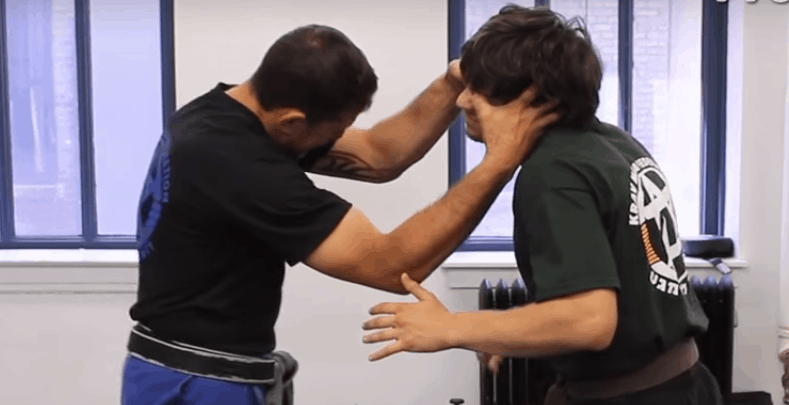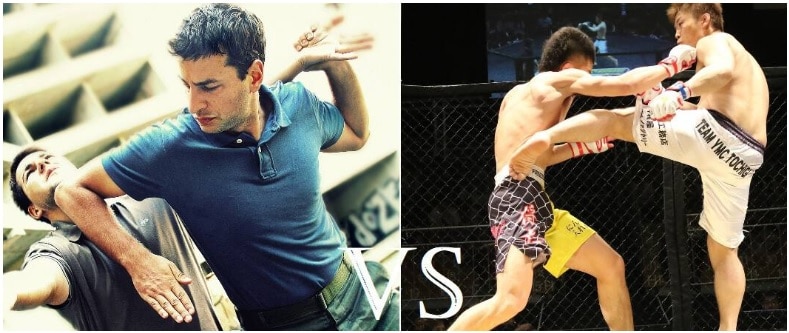
Even if you’re not really into the whole martial arts scene, you’ve probably considered attending some kind of fight class or gym to learn how to defend yourself on the streets or in real-life situations. It may be apt to say at this point that Krav Maga is a fighting system designed specifically for self-defense situations, but will this fighting style hold up as effective in a real-life and street situation?
So How Effective Is Krav Maga In A Real Fight?
Krav Maga is effective in that it is a potent fighting style, highly effective and specifically designed to neutralize opponents in unexpected or unprepared situations, first by avoidance and then by physical protection. So, the approach and psychology behind Krav Maga is very different as oppose to martial arts or other sports-centered fight styles.
That said, if a Krav Maga student were to face a well-trained martial arts student in the ring, they’d probably come up short. The advantage of Krav Maga is outside the ring, where there are more variables in play and the objectives of fighting are very different. [Krav Maga real-life street footage below]
Is Krav Maga The Best Form Of Self Defense
Yes, Krav Maga is one of the best and very effective form of self-defense for street fights, invented for real-life situations, surviving unfair disadvantages which may include multiple attackers and weapons and not intended as a sport or competition that’s governed by rules.
How so?
In martial arts, you’re usually trained to fight one on one for as long as you can. There are usually no weapons, and there is always a strict set of rules to avoid injuries getting out of hand.
In Krav Maga, some of the first things you’ll learn are:
- What is Krav Maga: An Israeli military self-defense fighting system with a series of aggressive strikes
- How to avoid a fight wherever possible.
- The goal of subduing your attacker as soon as possible.
- You’ll learn to fight against multiple attackers – so literally Krav Maga vs Thugs and Gangs are your likely scenarios since they’re notorious for fighting with unfair advantages and no rules.
- How to disarm someone of dangerous weapons first, using techniques that will reduce your risk of injury
- How to arm yourself using any instruments or common items around you to your benefit. (You’ll also hear this in the terrorist street right video below)
No rules apply in street fights and the person who can inflict the most damage in the least time (usually in a few seconds) wins the fight, or should we say survives that threatening situation.
So, in a nutshell, that is the mindset you’re trained for in Krav Maga.
How Would I Apply Krav Maga For Self Defense
We’ll be brave to say that Krav Maga is the closest art to what you’ll want for self-defense. You won’t need to adapt the techniques you learn to self-defense situations, that’s already been done for you. Krav Maga teaches you a wide range of martial arts moves that are both practical in self-defense and relatively simple to carry out.
Why?
It’s not all about fighting, either. There’s a heavy emphasis on awareness of your surroundings and how to identify and avoid a potentially dangerous situation. You will learn techniques to de-escalate heated situations without coming to blows and how to recognize when force is needed.
So Then, Is Krav Maga Dangerous?
If you’re trying to determine whether having Krav Maga as a skill would be a fierce force to be reckoned with, then your short answer would be:
Yes! Krav Maga can be dangerous if you are serious & learn to apply all the striking hits to your opponent’s eye, nose, throat, groin and more. On the contrary, if you plan to purpose Krav Maga only as a hobby or gym workout, then don’t expect to be a threat when danger comes your way.
It’s only fair to say that Krav Maga is or isn’t dangerous based on the fighter or learner. It’s much like saying that a gun is dangerous without considering its user ie. police vs a criminal – 2 distinct purposes and uses. Krav Maga used by a criminal can be very destructive, whilst a lifesaver to someone defending their life.
So, as an advanced fighter using it as an offensive weapon – it’s dangerous, while a life skill as a defensive technique.
Let’s also remember that the above also depends on how much of an advanced or experienced Krav Maga fighter you wish to become.
Below is a classic case of the effectiveness of Krav Maga in a real-life street fight where an Israeli man uses his skills to restrain a terrorist attack in a real-life street footage!
How Long Would It Take To Learn Or Master Krav Maga?
Krav Maga takes 1-2 years to learn the Basic 6 levels, another 2 years for the Graduate 5 levels, and more than 5 years to learn the Expert 5 levels. In Summary, you can take 2-3 years to be a serious fighter if you train 2-3 times a week consistently. Ultimately, it all depends on how fast you learn based on your past fighting experience and the proficiency you’d like to be in this art of fighting.
To break this down a bit further, let’s understand the different levels of learning Krav Maga…
To put this into perspective, Krav Maga has sixteen levels, split into three categories
Practitioner: levels 1-6.
- Practitioners learn the basics of self-defense and focus on improving their technique.
- Duration: It takes 1-2 years to move through all the levels of practitioner.
Graduate: levels 1-5.
- Graduates learn how to handle more complicated situations.
- Duration: It takes about 2 years to move through all five levels of graduate training.
Expert: levels 1-5.
- Grading in the Expert category is by invitation only, when it is felt that a graduate displays exceptional skill and dedication to the discipline.
- Duration: Traditionally this is only after 9-10 years of training, and invitations to proceed to each of the next 4 levels are only offered after 5 years in each one.
The level of Master exists above Expert, but it’s pretty much reserved for original disciples of Imi Lichtenberg who have spent most of their lives dedicated to Krav Maga. So if, like me, by “master” Krav Maga you mean “get the hang of most of the main stuff and be able to use it well”, you’re looking at two to three years of regular training, at least.
If you’re being literal about mastering it you’ll need to train every day for the rest of your life, and preferably in Israel, under one of the current masters! If you were disappointed that I would take this long, be consoled in knowing that other fight styles would actually take much longer.
Krav Maga is designed to be quicker to grasp than other martial arts, but you’re still looking at years of regular training to become proficient. How long it takes depends on your fitness and background to start. It’s obviously going to be a lot easier for someone in good shape with previous martial arts training.
Krav Maga Techniques & Fundamentals
Situational Analysis:
Basically, Krav Maga’s techniques aim to teach you how to stay safe in dangerous situations. The starting point for that is learning to be aware of your surroundings, recognize threats, and how to evade them wherever possible.
The Actual Krav Maga Background:
The Israeli fighting style Krav Maga draws from a range of martial arts. The system was developed by Imi Lichtenfeld. The young Lichtenfeld had organized a group of boxers and wrestlers to defend Jewish neighborhoods against anti-Semitic violence in the 30s in then Czechoslovakia.
Although he was an accomplished wrestler and boxer, his experience on the street led him to realize that the controlled techniques of martial arts needed to be adapted to the fast-paced aggression of street fighting to be effective in real life. He developed a system focused on physical aggression, using the simplest and most effective moves from his fight training to respond quickly and effectively to an attack.
Lichtenfeld moved to Israel as the Nazi movement gained momentum, and taught Krav Maga in the Israeli Defense Force. He added more techniques to the system over time, and eventually adapted it to teach it to civilians.
Fight Combinations:
The fight techniques you learn in Krav Maga are taken from martial arts like Aikido, Judo, and Jiu Jitsu. You’ll learn good fighting stances, different kinds of attacks, different kinds of defense, throws, and grappling. The technique is invaluable but like most things practical, it’s not much value without experience. A fundamental aspect of Krav Maga training is sparring with a partner.
Minimal Krav Maga Gear That Did The Trick For Me
This means you’ll need good protective gear to use for the majority of what you learn without inflicting serious damage. If you’re starting off, you wouldn’t want to be injured before you get past the first few classes. If you’re looking for something to get, we can recommend this pair of this leather Krav Maga gloves that we got within a day of ordering from Revgear.
We liked that it’s so narrow they can squeeze through our opponent’s defenses while providing supreme knuckle protection with extra high-density padding for heavy-hitting.
After mine went out of stock, my sparring partner had to wait a bit and after learning the hard way, we also got this all-in-one protective headgear which surprisingly reached us in time for our next sparring session the next day, it’s great because it protects the face, cheek, ear, and mouth.
A quick note here, this headgear was so great in that we saved on not having to use a mouth guard due to its extensive face and mouth protection. This was just our choice. (Review video at the end of this article)
The great benefit of sparring is that it will make you habituated to the stress of high-intensity fight situations.
Is Krav Maga Better Than MMA?
Yes, Krav Maga would better serve you in self-defense in a real-life situation on the streets, against multiple attackers, but not in an MMA ring.
To put this into real terms, if a Krav Maga student were to fight an MMA student in the ring, a krav maga student is likely to lose because of the nature of rules and regulations that govern MMA. However, on the street, where there are no rules, Krav maga would be your quick & lethal way to end a fight.
Let’s look at this a little further,
- Firstly, we didn’t define what is meant by ‘better’ in the above statement
- Second, we said ‘in a ring’,
- And lastly, I would say that MMA being better is slightly biased since that’s what the MMA guys seem to be convinced of in a healthy debate on genius.com. (if you’re keen to check it out at genius.com/discussions/264131-Krav-maga-vs-MMA.)
RELATED POST:
Krav Maga VS MMA – 21 Comparisons & Differences In Fight Style
I have to say, I tend to agree. BUT… In like terms, let’s be equally realistic, this also depends on each fighter’s application, physical strength, endurance, individual reflex, skill levels, and more. For this instance, we’re talking about self-defense or fighting on the streets. Even though like Krav Maga, MMA draws from whichever martial art is most effective in a particular circumstance, the approach is very different.
In short, MMA in most cases practiced and designed for the ring! Most often, if you’re interested in learning Krav Maga, you have no intention of entering a cage fight, instead, you want to know how to defend yourself, and for that… Krav Maga is definitely ‘better’ than MMA! [For a more detailed comparison on this topic, check out our article on Krav Maga VS MMA – 21 Comparisons & Differences In Fight Styles]
Wrap up…
Overall, Krav Maga is a great option if you’re interested in learning self-defense or being able to protect yourself in a street fight. The reflexes you train in Krav Maga are specific to defense situations, and the learning curve is a lot quicker at first. Whether you’re a complete novice or skilled in martial arts, the Krav Maga system will at least give you a better chance of staying out of danger on the streets.


